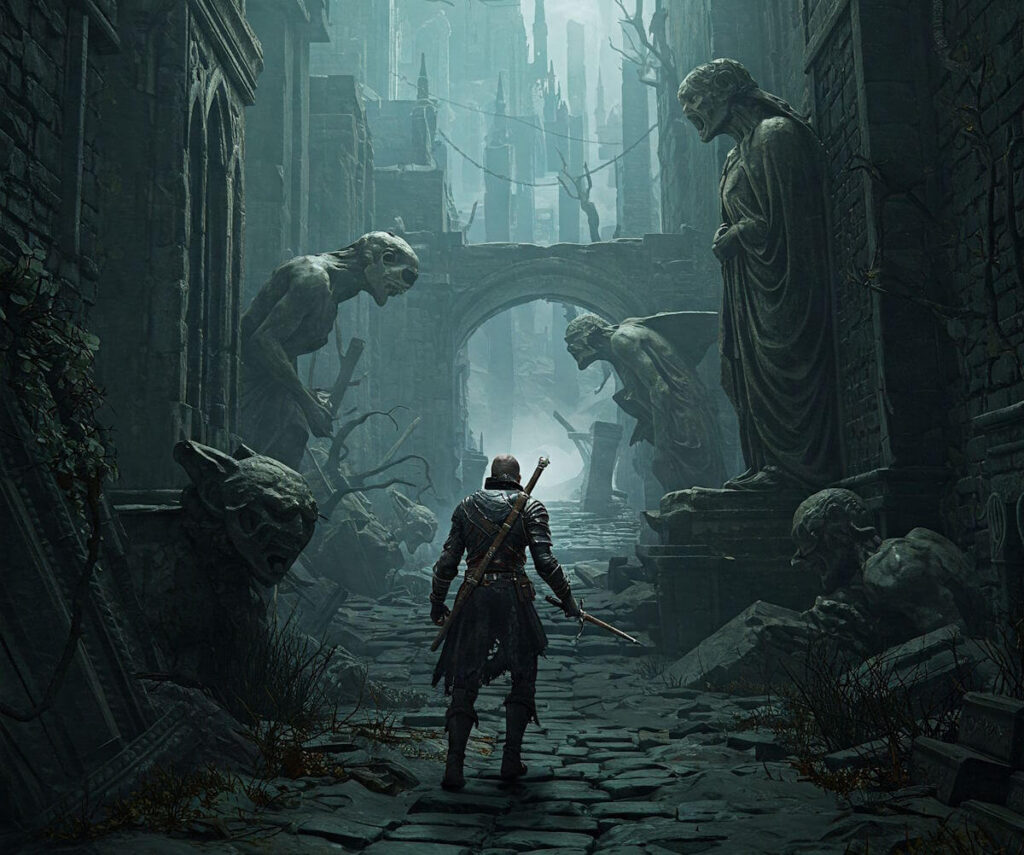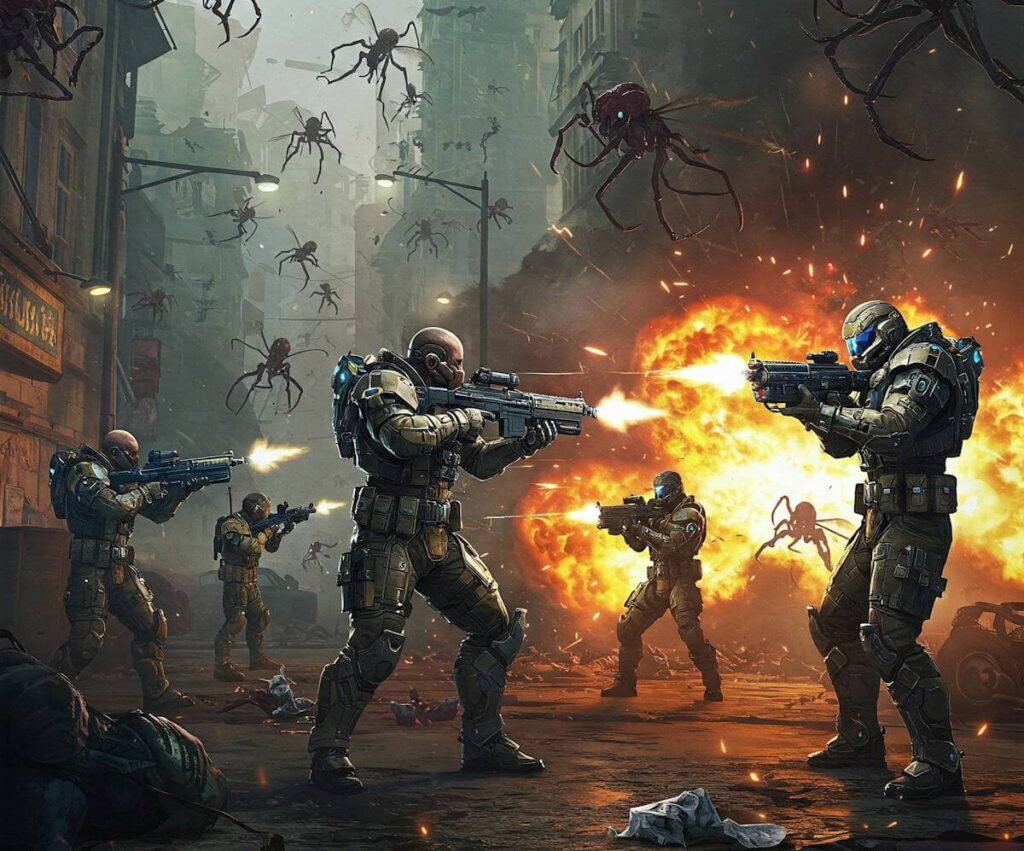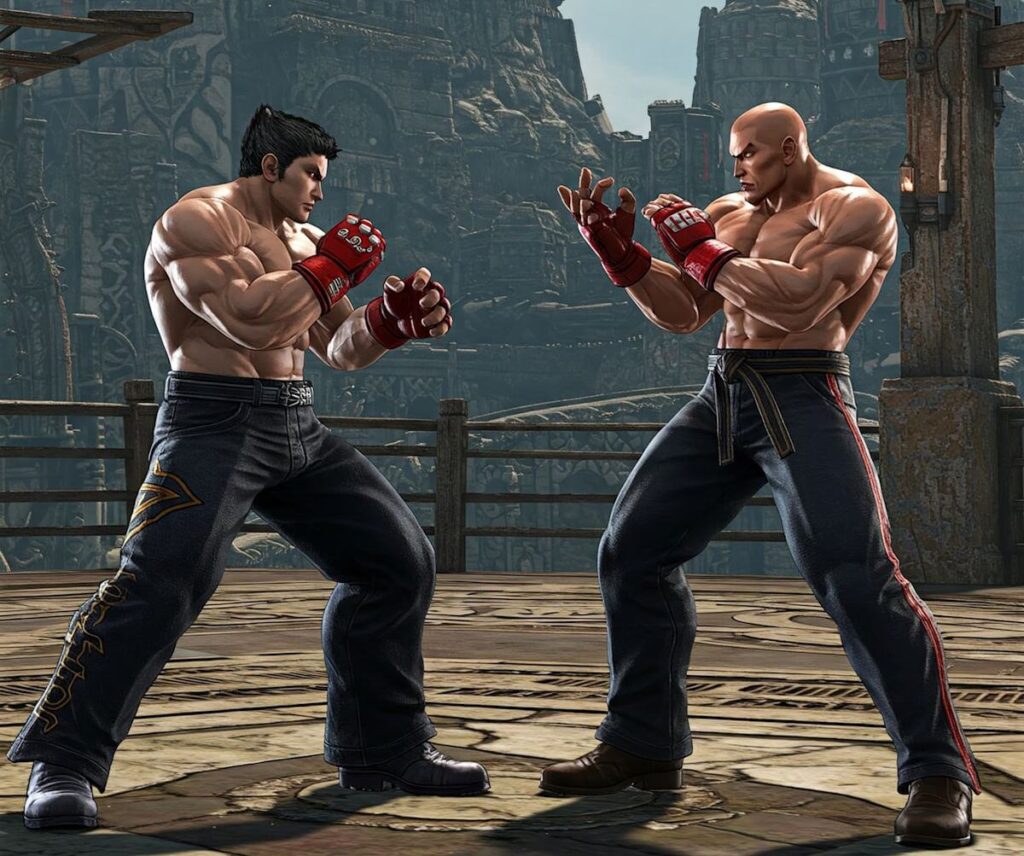“Lords of the Fallen,” released in October 2014, is an action role-playing game that has garnered attention for its similarities to the acclaimed “Dark Souls” series. Developed by Deck13 Interactive and published by CI Games, it was designed to offer players a challenging experience reflective of the beloved dark fantasy genre. As a direct competitor within the action RPG realm, “Lords of the Fallen” aims to blend intricate storytelling with engaging gameplay mechanics, carving out its own niche among players who appreciate thematic depth and tactical combat.
The development of “Lords of the Fallen” was marked by ambition. The creators sought to build a robust gaming environment, balancing challenging gameplay mechanics with expansive lore. Drawing inspiration from the punishing nature of “Dark Souls,” the game incorporates features that resonate with fans of hardcore gaming, such as unforgiving enemy encounters and a rich, atmospheric world. Moreover, the game introduces a dual-realm mechanic, allowing players to traverse between the living world and the realm of the dead. This unique gameplay feature not only enhances the narrative experience but also adds strategic depth, as players must adapt their tactics depending on the realm they inhabit.
“Lords of the Fallen” is often described as accessible yet challenging, making it suitable for both newcomers and veterans of the genre. The game features a variety of character classes and skill trees, offering players the freedom to customize their play style, whether they prefer melee combat or ranged abilities. This flexibility, combined with a captivating story of redemption and confrontation with the dark gods, positions “Lords of the Fallen” as a significant title in its genre, setting a solid foundation for subsequent entries that would further explore its universe.
Gameplay Mechanics: A Deep Dive
The gameplay mechanics of ‘Lords of the Fallen’ provide an intricate tapestry woven from traditional action RPG elements while introducing unique features that set it apart from its predecessors. Central to the experience is the combat system, which emphasizes precise timing and strategic decision-making. Players engage with a variety of melee and ranged weapons, each offering distinct advantages and requiring different strategies to master. This focus on combat aligns it closely with games within the Souls genre, yet Lords of the Fallen injects a more fluid dynamic through its enhanced combo-based attack sequences.
Character classes in ‘Lords of the Fallen’ further diversify gameplay, with various archetypes such as Warrior, Rogue, and Cleric. Each class is equipped with specific abilities and playstyles that cater to different players’ preferences. This structure allows for extensive customization, encouraging players to experiment with different builds and tactics as they progress. As players gain experience, they can level up their characters, enhancing attributes and unlocking powerful skills that significantly impact gameplay. The leveling system incentivizes exploration and strategic engagement with the environment and enemies.
The game’s strategic elements are further enriched by its dual-realm mechanic, where players transition between the realm of the living and the realm of the dead. This concept not only adds layers of complexity to gameplay but also influences the narrative direction. Encounters and challenges differ significantly across realms, necessitating adaptable strategies and thoughtful resource management. When compared to Dark Souls, Lords of the Fallen retains a punishing difficulty yet integrates refined mechanics that provide a fresh experience.
In summary, the mechanics of ‘Lords of the Fallen’ expertly blend traditional RPG elements with innovative features, crafting a gameplay experience that appeals to both new players and fans of the Souls genre. From its combat system to character customization and strategic gameplay elements, this game successfully carves its own identity within a familiar landscape.
Art and World Design: A Visual Journey
The visual presentation of ‘Lords of the Fallen’ plays a vital role in its appeal, seamlessly intertwining the game’s narrative with its aesthetic qualities. The art direction draws inspiration from gothic architecture and dark fantasy themes, creating an atmosphere that is both foreboding and mesmerizing. The meticulous design of the game’s environments serves to enhance the immersive experience, allowing players to become deeply invested in the world around them. From crumbling castles to vast, desolate landscapes, each area is crafted with attention to detail, encouraging exploration and discovery.
Additionally, the color palette of ‘Lords of the Fallen’ reinforces its thematic focus on duality and contrast. Dark hues dominate the environments, symbolizing the struggles faced by the protagonist as they navigate through a corrupt world filled with foreboding entities. The delicate balance of light and shadow not only enhances the game’s haunting ambiance but also mirrors the internal conflicts that resonate with players familiar with the Souls-like genre.
The character design is equally impressive, showcasing a range of grotesque enemies alongside intricately detailed protagonists. Each character is unique, with visual traits that often allude to their backstory or role within the narrative. This investment in character artistry enhances the storytelling element of the game, allowing for a connection between the player and the characters they encounter.
Moreover, the world design encourages players to interact with their environments in meaningful ways. Dynamic elements, such as destructible terrain and atmospheric effects, contribute to the overall gameplay experience, reinforcing the feeling of being in a living, breathing world. The level of interactivity aligns with the high standards set by other titles in the Souls-like genre, ensuring that ‘Lords of the Fallen’ is not only a visual treat but also a richly engaging adventure.
Lore and Storytelling: Crafting a Rich Narrative
The narrative framework of ‘Lords of the Fallen’ delves deep into a carefully constructed world, rich with mythology and history that echoes the intricate storytelling found in traditional Souls games. The plot unfolds in a realm plagued by darkness and tyranny, where players assume the role of Harkyn, a condemned man tasked with vanquishing a malevolent force known as the Rhogar. This overarching storyline effectively mirrors the moral complexities and existential themes often celebrated in the Souls genre.
Character development is another paramount aspect of the game’s lore. Harkyn’s journey is not merely a quest for redemption; it allows players to explore his inner turmoil and the consequences of his past decisions. As players progress through the game, they encounter various NPCs, each with their own backstories and motives that weave seamlessly into the larger narrative fabric. These interactions are pivotal, as they enrich the player’s experience, providing multiple layers to the overarching story that compel players to invest emotionally in their characters and quests.
The world-building within ‘Lords of the Fallen’ is meticulously crafted, offering a visually stunning and immersive environment that enhances storytelling. From ancient temples to treacherous wastelands, each locale is imbued with lore that invites exploration and engagement. Environmental storytelling is particularly pronounced; players find remnants of past battles, inscriptions, and hidden secrets, all contributing to understanding the game’s history and current conflict. With such depth, the game effectively captivates players and draws them into a complex mythology that rivals that of its Souls counterparts.
In conclusion, ‘Lords of the Fallen’ excels in crafting a rich narrative experience through its intricate lore, character development, and meticulous world-building, establishing itself as a formidable competitor in the realm of games that draw inspiration from the Souls series. The synergy of these elements not only engages players but also encourages exploration of its mythos, resulting in a memorable journey.
Enemies and Boss Fights: A Challenging Experience
The enemy design and boss fights in Lords of the Fallen present a compelling challenge that sets it apart as a worthy rival to the acclaimed Dark Souls series. The array of adversaries players encounter throughout the game is notable for its diversity. From swift, acrobatic foes to hulking giants, each enemy requires different tactics and strategies, enhancing the game’s overall difficulty and engagement. These combat encounters demand players to adapt quickly, testing their skills and understanding of the game’s mechanics.
Moreover, the artificial intelligence (AI) that governs enemy behavior is finely tuned, providing unpredictable and often ruthless aggression. For instance, certain enemies may employ ambush tactics, coercing players to remain vigilant and cautious as they traverse the game’s dark environments. This unpredictability elevates the tension of each encounter, compelling players to thoughtfully analyze their surroundings and adapt their strategies accordingly. As players progress, the challenge typically escalates, ensuring that combat remains exhilarating and rarely feels repetitive.
Boss fights in Lords of the Fallen further exemplify the game’s commitment to challenging gameplay. Each boss is not only a test of skill but also a spectacle, with unique designs and combat mechanics that reflect their lore and significance within the game world. The intricacies of these battles often require mastery of dodge timings, attack patterns, and positional awareness, similar to the boss encounters in Dark Souls. While each series has its distinctive flair, the boss fights in Lords of the Fallen successfully evoke that same level of dread and excitement, making victory all the more rewarding. These encounters are pivotal moments that contribute significantly to the overall narrative and player experience, inviting a deeper connection between the character and the challenges they face.
Co-op and Multiplayer Features
‘Lords of the Fallen’ introduces an expansive array of co-op and multiplayer features that significantly enhance the gameplay experience. Players can join forces in a cooperative mode, allowing them to battle through the game’s intricately designed world together. This collaboration mirrors certain elements found in the Souls series, yet it also carves its unique identity within the genre. Players can summon friends into their game world, enabling them to tackle challenging enemies and complex boss fights as a unified team.
In cooperative gameplay, players can share combat responsibilities, strategizing to take down formidable foes more effectively. The inclusion of a shared experience system means that both participants gain valuable rewards and combat experience. Additionally, the game encourages players to explore the deeper elements of character progression together, fostering a more immersive and engaging experience. This social aspect of ‘Lords of the Fallen’ aligns with the camaraderie often celebrated in the Souls games, while also offering its distinctive approach to teamwork.
Conversely, ‘Lords of the Fallen’ also includes competitive multiplayer elements. Players have the option to invade others’ games, leading to spontaneous PvP encounters that can dramatically shift the tides of battle. This intrusion adds an exhilarating layer of unpredictability, distinguishing it from the primarily cooperative focus found in many entries of the Souls series. Players must be mindful of their surroundings, as other combatants may appear at any moment, forcing them to adapt their strategies rapidly. By blending both cooperative and competitive gameplay, ‘Lords of the Fallen’ caters to a wide array of player preferences, making for a diverse and engaging experience.
Community Reception and Critique
The release of “Lords of the Fallen” has prompted varied responses within the gaming community and among critics alike. While some players laud the title for its ambitious design and engaging gameplay, others have voiced reservations, particularly when compared to established Souls-like games. The game has been scrutinized not only for its mechanics but also for its overall execution within the challenging RPG genre.
Critics have highlighted the game’s intricate world-building and richly designed environments as significant strengths. The dark fantasy aesthetic resonates well with players who appreciate atmospheric storytelling similar to that found in other Souls-esque titles. Reviewers have noted the incorporation of deep lore that can be uncovered through exploration, which enhances player immersion. However, where the game seems to falter is in the technical execution; several reviews pointed out issues such as inconsistent combat mechanics and occasional performance dips during demanding sequences.
Player feedback further amplifies these critiques, with many community members echoing concerns about combat fluidity and enemy AI behavior. Some players have drawn comparisons to the “Dark Souls” series, suggesting that while “Lords of the Fallen” attempts to honor its inspirations, it occasionally struggles to match the refined feel and challenging difficulty that fans crave. Furthermore, some community discussions have focused on the game’s pacing, noting that certain sections can feel sluggish or overly drawn out, which detracts from the overall experience.
The willingness of players to embrace “Lords of the Fallen” has been tempered with constructive criticism, showcasing a desire among the audience for continual improvement. As the community continues to engage through forums and social media, developers are likely paying close attention to feedback, which could shape future updates and refinements. Overall, the game sits at a crossroads of admiration and critique, reflecting both its potential and areas that require further development.
Current Trends and Future Developments
The action RPG genre has experienced significant evolution in the past few years, reflecting changing player preferences and technological advancements. As a prominent entry in this space, “Lords of the Fallen” is poised to adapt to these trends. One prevalent trend is the increasing integration of online multiplayer features within traditionally single-player games. This shift caters to a growing demand for cooperative and competitive experiences, allowing players to engage more dynamically within game worlds. It is likely that future iterations of “Lords of the Fallen” will explore these multiplayer dynamics to enhance overall player engagement.
Moreover, the current trend towards accessibility is reshaping game designs across the industry. Developers are increasingly focused on creating experiences that accommodate players of varying skill levels and physical capabilities. As “Lords of the Fallen” evolves, it may implement more robust accessibility options, aligning with the industry’s best practices. Such developments not only enhance player satisfaction but also broaden the potential audience, fostering inclusivity within the gaming community.
Looking ahead, sequels and expansions for “Lords of the Fallen” may be heavily influenced by player feedback. Development teams are increasingly reliant on community insights to shape their future projects. This participatory approach ensures that upcoming content resonates with players’ desires, making it essential for creators to remain in tune with player expectations and trends. The potential for new storytelling elements, enhanced gameplay mechanics, and intricate world-building within sequels can keep the “Lords of the Fallen” series fresh and engaging.
As the action RPG market continues to evolve, it is clear that “Lords of the Fallen” will need to stay attuned to both industry trends and player desires. In doing so, the franchise can ensure its relevance and success in an increasingly competitive landscape.
Conclusion: Is Lords of the Fallen a True Rival to Souls?
As we evaluate the position of Lords of the Fallen within the gaming world, particularly in relation to the esteemed Souls series, it is essential to reflect on its life cycle and the reception it garnered from players and critics alike. Launched initially in 2014 and receiving a sequel, this franchise aimed to carve out its own niche amidst heavy competition, especially from the renowned Dark Souls titles, which are celebrated for their intricate lore and challenging gameplay.
Throughout its journey, Lords of the Fallen has often been acknowledged for its combat mechanics, which blend fast-paced action with a structured level of difficulty reminiscent of the Souls franchise. The game incorporated rich environments and an engaging combat system that draws parallels to the signature styles that fans of the Souls games have come to love. However, as players dissect these elements, they are often faced with the question of whether it lives up to the monumental expectations set by its predecessors.
Critical reception indicated a mixed bag, with some praising the innovative concepts introduced in Lords of the Fallen, while others felt it fell short of the exceptional benchmarks established by the Souls series. The visuals, world-building, and character designs received commendations, yet some critics pointed out issues related to pacing and narrative depth. While Lords of the Fallen has endeavored to innovate and provide a refreshing experience, it has at times been overshadowed by the intricacies and impact of its celebrated counterparts.
In light of these considerations, one could argue that while Lords of the Fallen has valiantly attempted to position itself as a worthy rival, it ultimately still resides in the shadow of the Souls series. As the gaming landscape continues to evolve, it will be interesting to see if this game franchise can solidify its identity and legacy in an ever-growing arena.





